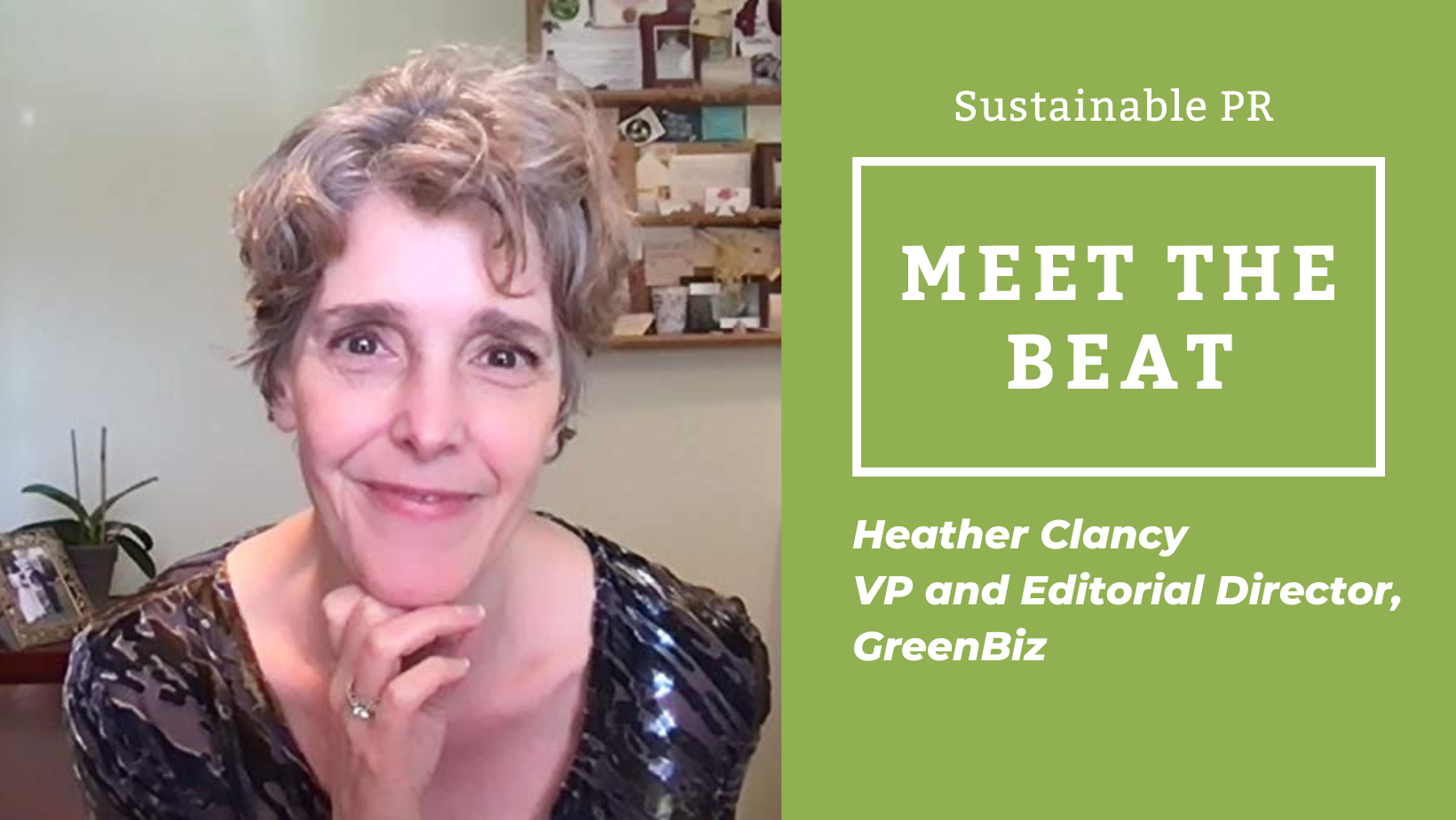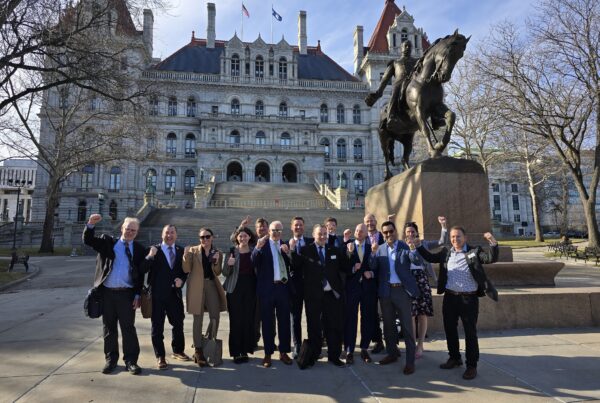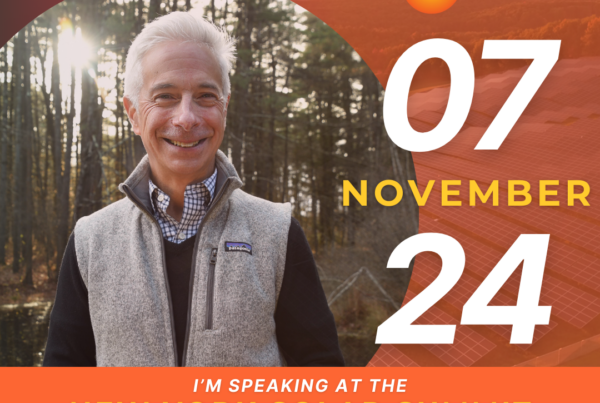What is Meet the Beat, you ask? It’s a Q&A series with the nation’s top green-journalists designed to garner insight into what is currently top of mind for journalists in the sustainability marketspace, and how best to approach them with a story that meets their beat!
For our first session, we sat down with Heather Clancy, vice president and editorial director at GreenBiz. The following is an abbreviated version of her responses.
What is the best way for companies to contact you?
The best way is to send me a detailed story pitch via email. I use it as a way of organizing ideas that might come to fruition as stories in the future. I have lots of folders that I keep of things that I can’t cover right away, but I think might be a story down the road.
What makes GreenBiz unique that companies should keep in mind when presenting a story idea?
[GreenBiz] is business to business. The news that we cover is focused on what a corporation would get out of another corporation. When I cover sustainability advancements, my interest is in what another company can learn from how [the company] did this. So, looking at what practical things an organization did that could be lessons for other sustainability professionals. When it comes to the technologies that I pick or we pick as a group, again, it’s how could this technology affect another company.
And you have approximately what, eight to ten staffers?
We currently have four full-time editorial folks at GreenBiz. However, we have three positions open, and we have a new senior VP of Products and Content who manages the editorial. So, there’s a lot happening. Stay tuned.
How many of your articles do you develop organically? As opposed to those that come from folks like us who are pitching a story they think has merit?
I would say that most of the stuff that I write for the newsletter has been pitched. I’ve got things that I’m working on that are organic, where I went to an event, I heard people talking, I decided that this was a story I should pursue and I’m pursuing that. So, I would say, half and half. There is a real opportunity to get me on a story. If there’s a really cool startup out there, or hey, did you notice this trend? Every once in a while, I’ll put something on my LinkedIn that says, hey, I’m trying to explore this, who’s out there? And I’ll get ideas.
What do you look for in a good story?
I look for detail. I also like to hear about something when there is some mileage to it. I want to know what happened in the program, and what makes something different from what someone else has done before or after?
The most recent [example] that is top of mind is a company called ECL, a startup.
What made it interesting to me was that it had a great executive at the front of it, who had good credentials as a technologist. And that they were able to provide external independent commentators for me. So, I was able to talk to someone about the technology. I think I have a good instinct, but I like to talk to experts and when a company can give me independent individuals that can talk about the development, that’s important.
What are the hot topics that you’re interested in right now that you’re following that you think are shaping the sustainability marketplace?
Things that have my particular attention right now are water technologies–technologies that help with addressing water shortages or that allow corporations to use water more effectively.
I am also fascinated with the ocean right now. And how the ocean could be a source of climate tech solutions that could help us in terms of climate change.
I also will say generally, two other areas: One is what is called nature tech, that includes things like sensors to monitor reforestation efforts, drones that could be used to seed areas and help cultivate forests. Also, biotech that mimic a process of nature and replace a material that’s made right now with petrochemicals.
And then just generally speaking anything that reduces a climate impact. I want to know what you actually did to make your impact less or to help the world and not just do less bad but do good.
What constitutes greenwashing in your mind?
Unfounded claims. Unverified claims. Overinflated claims. And anything that’s meant to obfuscate or confuse me; it makes my antenna go up.
How do you establish what is newsworthy versus what a company may be very excited about but the innovation itself just may not reach the threshold of being newsworthy for GreenBiz?
I want to talk to companies about that latter and to understand why they think it’s so exciting. I don’t like to discourage innovations but I’m not necessarily going to cover it. So, for me, it might be interesting to speak with someone [on background] about it and establish a relationship and then when there’s something bigger down the road, that gets covered.
But I think every journalist could benefit from having more time to source their beat and to understand what’s on the mind of the people that they’re talking to and interviewing before there’s an interview and you’re going to be quoting them and they know they’re on the mic.
You have mentioned in other interviews that journalists must adapt their voice to fit the publication that they’re writing for. How can this advice be tailored to fit the voice companies need to adopt when addressing journalists such as yourself?
To my point earlier, I think a lot of companies believe that GreenBiz covers green businesses. I feel like a lot of the more junior level public relations or marketing individuals that contact me haven’t read the site or the newsletter. It feels like they’re just blasting out press releases and haven’t taken the time to adapt the email for my audience. We have a very specific business to business focus and the way that something’s pitched often doesn’t speak to that. I will sometimes come back to an email and say, okay, sounds like a great company, but how does it fit? How do they work with corporations? What’s the angle for GreenBiz? Also, if you’re pitching five of us, let the five of us know that we’re all on this pitch.
In your role as editorial director at GreenBiz, how do you determine which content is published?
First of all, GreenBiz has a combination of stories on our site. Everyone has an area of focus. The analysts and editors work together. The analysts aren’t responsible for being news reporters, they have their realm of responsibilities, but they are responsible for connecting with us to understand what should be covered. So, I’m very much at the center of that.
I’m also at the center of the freelance assignments. I work with the team on assigning things for the different sections of the site we don’t have the resources to handle. And at this moment, I am also vetting the external contributions. We don’t publish that many of them. We will publish true thought leadership, but I am always very [careful] to look at who the person is we avoid pretty much anything that could be construed as marketing content.
At GreenBiz, do you see, or do you anticipate the level of contributors increasing or is it the view of the publication, let’s keep it a balance?
To be determined, I would think. For the first time since I’ve been with the company, we’re really starting to invest in our newsletter portfolio and in the website and what the website wants to be. So we’re actually in the middle of a strategic shift. My gut feeling is that right now we’re downplaying other contributors. I don’t think we’re hunting or trying to build up the columnist portfolio right now primarily because we’ve got some strategic stuff that’s going on behind the scenes.
Is there something that public relations people can do to win you over? In addition to just having a really good story.
Read the website, read the newsletters and understand what GreenBiz is about and understand what we’re trying to accomplish. And if you don’t understand after reading it, ask me. I would also say, understand that journalists are not living on email. I [easily get] one hundred emails a day and I can’t answer them all. Understand that we can’t respond all the time, it just is humanly impossible. So just have a little patience.
How do you feel if a story is basically just resent to the top of your inbox?
Maybe just don’t do it on Monday. I do get that and I’m not trying to make anyone’s job harder. Monday is my absolute worst day to deal with email and invariably, it’s when everyone bounces it at the top of the inbox. I don’t mind, I think it’s reasonable. But maybe also only do it twice and then just know that I’m not going to answer. I haven’t answered because it didn’t make sense.
And the one other thing I just want to say is when we have the opportunity not to be transactional, let’s take it.





